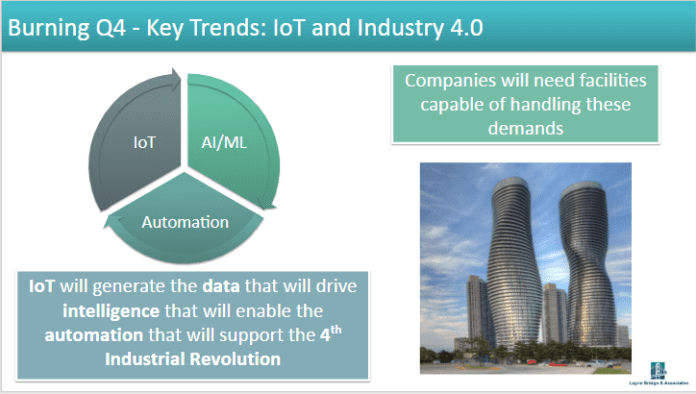?IoT will generate the data that will drive intelligence that will enable the automation that will support the Fourth Industrial Revolution.?
Not to toot my own horn, but I said that? in a webinar? that you can listen to by clicking HERE. The key point that I was trying to make is that without IoT, a lot of what the industry is talking about with respect to the need for pervasive in-building connectivity falls a bit flat.? While it is true that millennials love their devices, and if we are going to expect them to show up for work, then we must ensure their ability to not only bring their own devices to the office, but also use them while at their desks.? At the end of the day, however, this is not enough of a business case to convince building owners who are mainly concerned with maintaining NOI thresholds to invest in expensive fiber-fed DAS solutions, or as-yet-unproven CBRS technology.
Where the proverbial rubber hits the road in terms of the need to equip buildings to handle the next wave of industrial automation is IoT. More pointedly, the massive proliferation of IoT sensors within a building?s four walls, and the need to connect those to the outside world is going to drive 5G; it will drive WiFi; it will drive LP-WAN; and, it will drive a long and healthy life for LTE (especially in the form of NB-IoT, LTE-M, etc.). Taking the concept to its logical conclusion, the need to support a mix all of these technologies will require building owners to get serious about connectivity if they want to keep their office space competitive in the Industry 4.0 era.
Industry 4.0 is for all
In addition to driving the need to outfit large venues, such as airports, large factories and shopping malls with comprehensive connectivity solutions, it will also be the thing that is driving the technology supplier ecosystem to develop innovative, low-cost small cells solutions that will make it tenable to outfit office spaces designed for the so-called ?middleprise? (aka, enterprises that occupy buildings that are less than 500,000 square feet).
Case in point, if a key opportunity area for IoT is in connected health, then arguably, smaller hospitals in rural or remote locations have as much, if not more, need for comprehensive in-building connectivity than hospital systems in large areas with a robust cellular infrastructure already in place. The same argument can be applied to factories, distribution facilities in rural areas, and, perhaps as important, commercial office space in urban areas that are ripe for gentrification.
To be clear, IoT and Industry 4.0 will not happen overnight. As such, neither will pervasive in-building connectivity. However, there is a confluence of societal, industrial, and technological forces that are coming together that will make it clear that in-building connectivity must improve in order for commercial real estate to keep pace with the demands of a modern economy. Nowhere is that more clear than in the need to support IoT.
For further reading on the subject please see:
- Feature Report: Can DAS, CBRS, Licensed Cellular and Proprietary LP-WAN Solve In-Building Connectivity?
- Smart Buildings 101: How connected is connected enough?
- In-building connectivity 101: DAS, CBRS and LP-WAN
- Trend Watch: What to look for in DAS, CBRS and LP-WAN development
- ROI vs NOI: Why should CRE invest in building automation?

